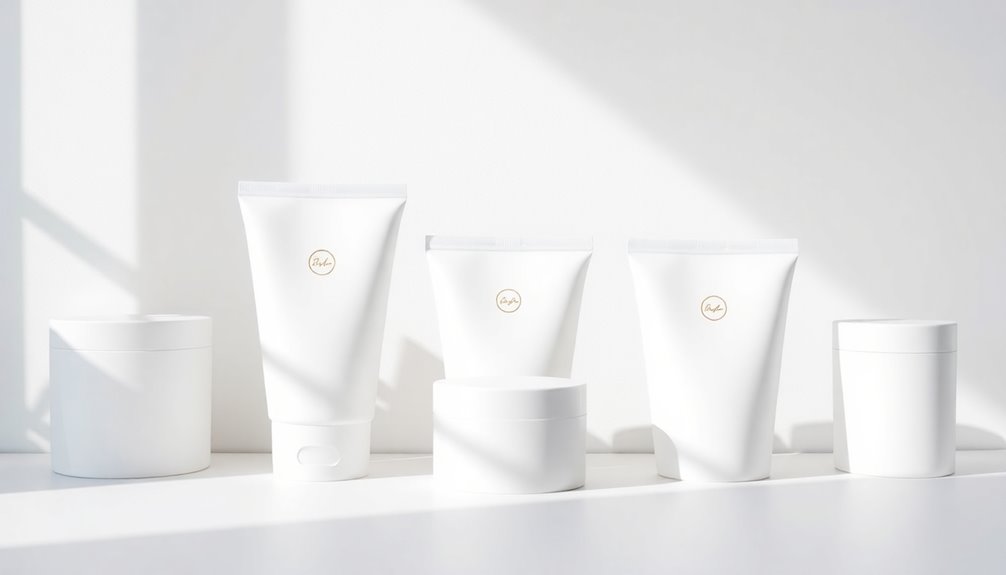Minimalism is reinventing product packaging by focusing on simplicity and sustainability. You'll notice cleaner designs that grab attention and reduce clutter in stores. These minimalist packages use fewer materials, which lowers production costs and appeals to eco-conscious shoppers. By enhancing user experience with straightforward aesthetics, brands create stronger connections with consumers. Plus, innovative materials and technologies are shaping the future of packaging. Discover how these trends are changing the landscape of product presentation.
Key Takeaways
- Minimalist packaging emphasizes clean aesthetics, attracting consumers and promoting a "less is more" philosophy in design.
- Reduced material usage lowers carbon footprints and aligns with the growing consumer preference for sustainable products.
- Simple designs enhance shelf appeal, making products stand out in retail environments and encouraging impulse purchases.
- Cost-effective minimalist packaging reduces production and transportation expenses, improving overall brand profitability.
- Future trends focus on biodegradable materials and technology-driven innovations, creating engaging and eco-friendly packaging solutions.
The Shift Towards Simplicity in Packaging Design
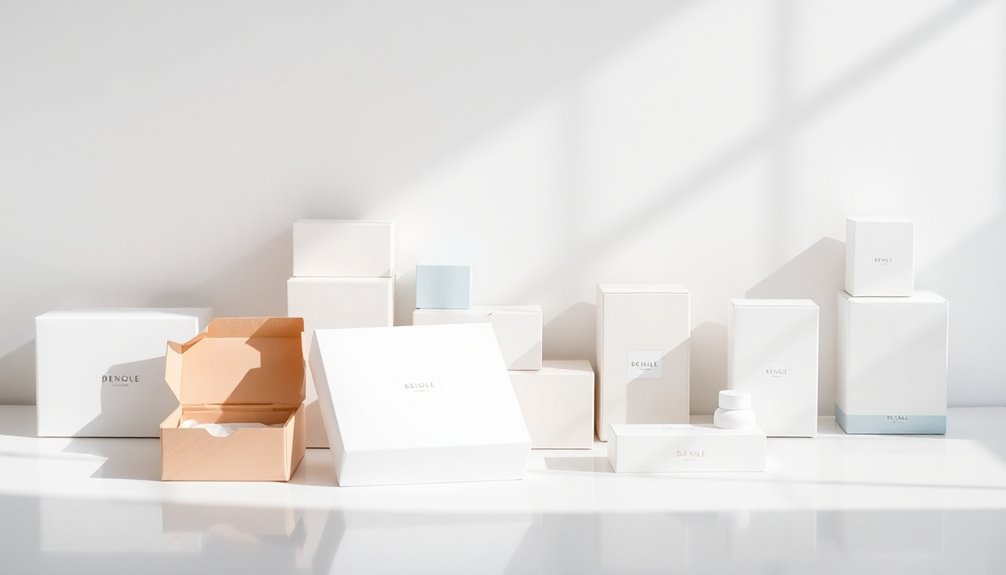
As brands recognize the impact of cluttered designs, they've increasingly embraced minimalist packaging to capture consumer attention. This shift highlights a "less is more" philosophy, where clean aesthetics allow products to shine.
Minimalist packaging not only fosters positive consumer perception but also promotes sustainability by using fewer materials and enhancing recyclability. About 30% of shoppers prefer sustainable products, making this approach even more appealing.
Minimalist packaging enhances consumer perception while promoting sustainability, appealing to the 30% of shoppers who prefer eco-friendly products.
By reducing unnecessary elements, you create a sophisticated user experience that emphasizes essential information during unboxing. Additionally, brands can enjoy reduced production costs and streamlined logistics, as simpler designs often require fewer resources.
In a crowded market, minimalist packaging can markedly increase impulse purchases, making it a smart choice for modern brands. This design philosophy resonates with the growing trend of sustainability in product design, appealing to environmentally conscious consumers.
Enhancing Shelf Appeal Through Minimalism
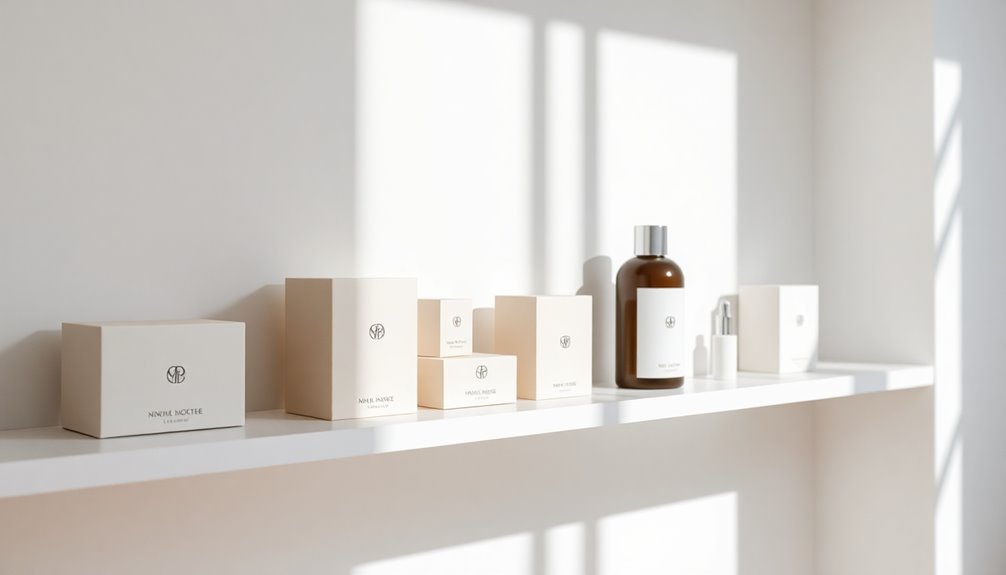
Minimalist packaging enhances shelf appeal by cutting through the clutter that often overwhelms retail environments.
With clean lines and uncluttered aesthetics, these designs draw your attention directly to the product. Research shows that simple, minimalist packaging creates a stronger visual impact, making you more likely to make impulse purchases.
Plus, nearly 30% of shoppers prefer products with eco-friendly materials, aligning with your desire for sustainable options. Brands using minimalist packaging effectively communicate their product's essential qualities, resulting in a clearer and more memorable brand identity. Furthermore, the growing interest in organic tea market highlights consumers' preference for sustainable and health-conscious choices, further reinforcing the importance of minimalist packaging.
By improving visual appeal and supporting easier recycling, minimalist packaging not only attracts your eye but also resonates with your values as a conscious consumer.
Embrace the shift towards simplicity and elevate your shopping experience.
The Environmental Benefits of Minimalist Packaging
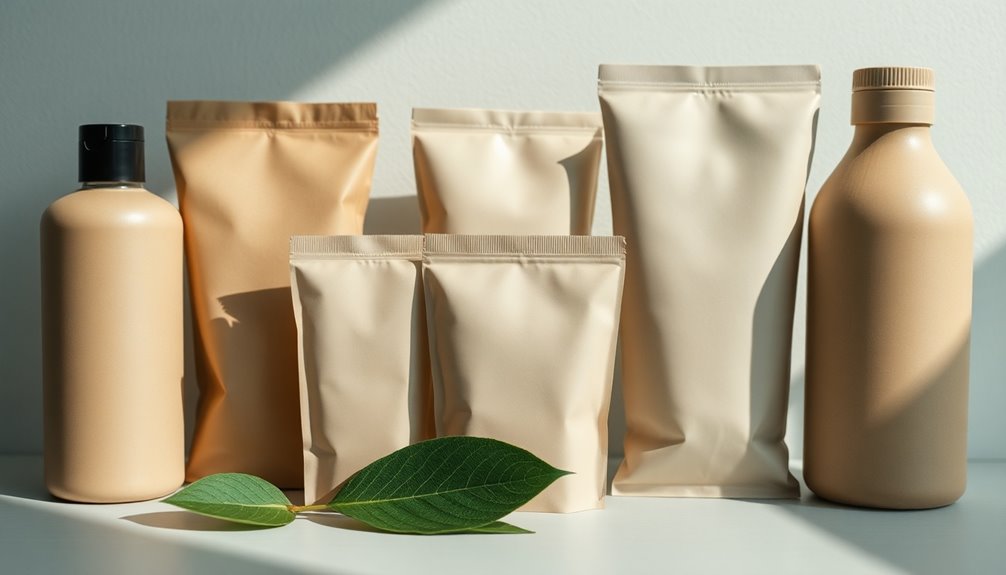
When you choose minimalist packaging, you're not just opting for a sleek look; you're also cutting down on material usage, which helps lower the carbon footprint. This thoughtful approach makes recycling easier and encourages more eco-friendly habits. Additionally, reductions in energy costs from efficient production processes can further enhance the environmental benefits of minimalist packaging.
Reduced Material Usage
By choosing minimalist packaging, you not only reduce material usage but also noticeably lessen your environmental impact. This approach considerably lowers your carbon footprint, aligning with the values of 30% of shoppers who prioritize sustainable products.
By utilizing fewer materials, you decrease energy consumption during production, contributing to a more sustainable packaging solution. Additionally, lightweight and compact designs optimize transportation efficiency, minimizing carbon emissions linked to shipping.
Adopting these practices not only alleviates landfill pressure but also appeals to eco-conscious consumers, with 72% more likely to purchase sustainably made products. Ultimately, embracing minimalist packaging enhances your brand's reputation while supporting a circular economy, making a positive difference for both the planet and your customers. Furthermore, similar to sustainable practices in butter production, minimalist packaging reflects a commitment to environmental responsibility across industries.
Enhanced Recycling Efficiency
Embracing minimalist packaging not only simplifies design but also greatly enhances recycling efficiency. By using fewer materials, it reduces overall waste and makes recycling easier for you.
When you choose products with minimalist packaging, you're supporting sustainable materials that align with eco-friendly practices.
- Minimalist packaging promotes a circular economy, effectively reducing resource use.
- Lightweight designs lead to lower transportation emissions, positively affecting the environmental impact.
- Consumers increasingly prefer sustainable products, with about 30% more likely to buy them.
- This approach mirrors the principles of Gold IRAs protecting against inflation, encouraging brands to invest in long-term sustainability.
This streamlined approach not only benefits the planet but also encourages responsible recycling habits, making it simpler for you to contribute to a more sustainable future.
Lower Carbon Footprint
Minimalist packaging greatly lowers the carbon footprint associated with product production. By using fewer materials, brands reduce energy consumption and waste, directly supporting environmental sustainability.
When you opt for minimalist designs, you not only minimize packaging waste but also help decrease landfill pressure, promoting a circular economy. Lightweight and compact packaging improves transportation efficiency, cutting down on carbon emissions during shipping.
Plus, with about 30% of shoppers preferring sustainable products, there's a growing demand for these eco-friendly alternatives. Embracing simpler packaging designs allows companies to align with consumer values while considerably enhancing their commitment to sustainable materials. Additionally, adopting eco-friendly minimalism promotes sustainable habits that enhance overall well-being.
In short, adopting minimalist packaging is a smart choice for both the environment and your brand's image.
Optimizing User Experience With Clean Designs
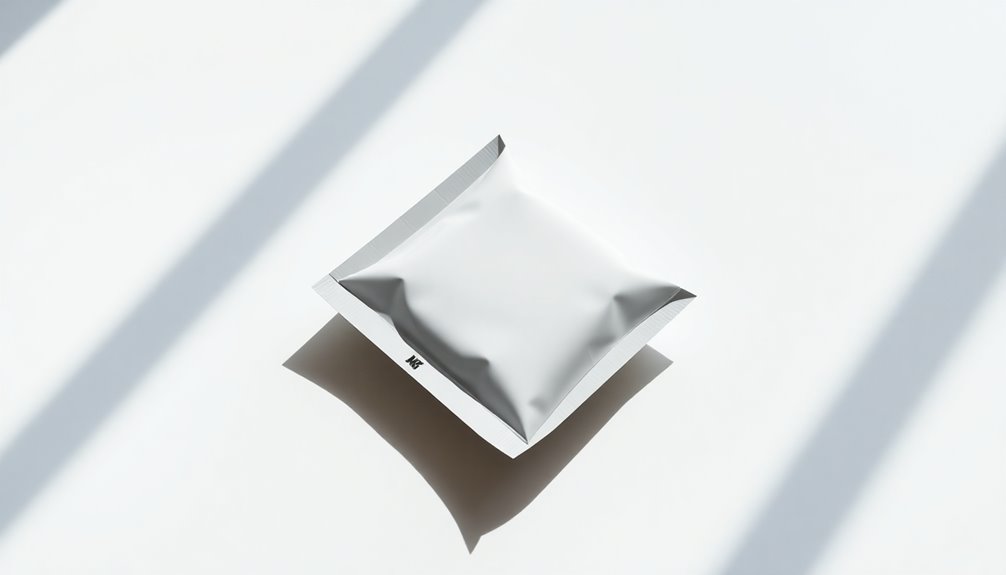
When you encounter clean designs in product packaging, the experience becomes instantly more engaging and straightforward. Minimalist packaging emphasizes essential product information, enhancing your user interaction.
This clarity reduces visual clutter, allowing you to focus on the product itself, which can lead to increased impulse purchases.
Consider these benefits of clean designs:
- Sophisticated unboxing: Elevates your anticipation and overall perception of the product.
- Eco-friendly appeal: Aligns with sustainable packaging that resonates with 72% of consumers favoring green choices.
- Innovative information access: QR codes can provide extra details without complicating the simple design. Additionally, the concept of tax-efficient growth in financial products mirrors the simplicity and effectiveness seen in minimalist packaging.
Cost-Effectiveness of Minimalist Packaging Solutions
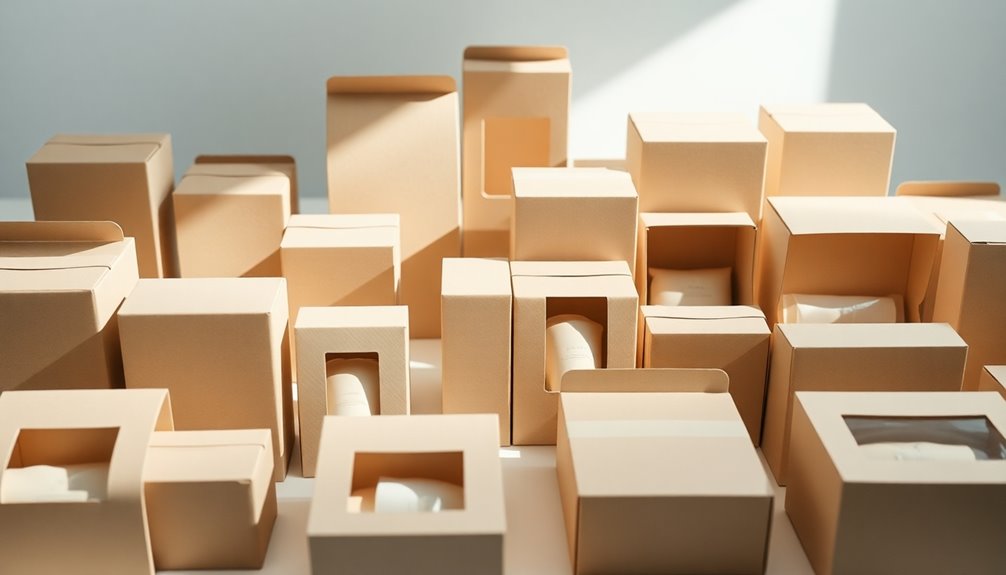
Clean designs not only enhance user experience but also bring significant cost savings to brands. Minimalist packaging is all about cost-effectiveness, as it reduces production costs by using fewer materials. This simplicity streamlines logistics and warehousing, cutting down on transportation expenses due to lighter, more compact designs. By adopting eco-friendly packaging, you align with sustainability initiatives, appealing to both your bottom line and eco-conscious consumers. These efficiency gains can also shorten time-to-market, lowering overhead costs. Ultimately, shifting to minimalist packaging not only creates a healthier bottom line but also positions your brand as a leader in sustainable practices. Embracing simplicity can lead to long-term profitability while enhancing your brand's image. Additionally, open communication about consumer needs can further refine packaging strategies, ensuring they resonate with your target audience.
Consumer Connection: Engaging Eco-Conscious Shoppers
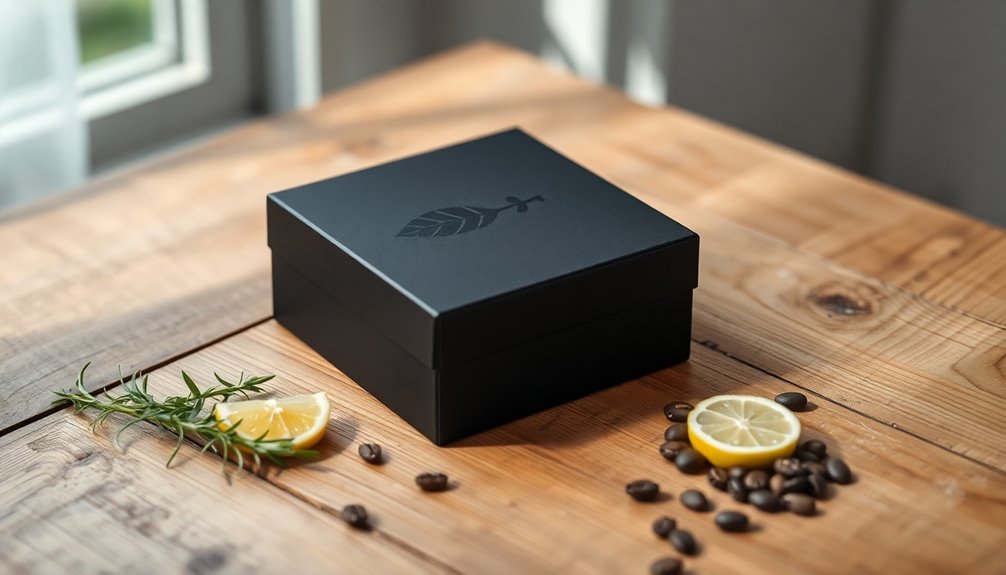
As consumers become more environmentally conscious, brands that embrace minimalist packaging are finding a stronger connection with this demographic. Eco-conscious consumers are drawn to simplified designs that reduce material usage and carbon footprints.
By utilizing recycled or biodegradable materials, these brands demonstrate a commitment to sustainability, enhancing brand perception and fostering loyalty.
- Nearly 30% of shoppers prioritize sustainable products.
- 72% are more likely to buy items with minimalist packaging that reflect product prestige.
- Clear, distraction-free designs highlight essential product details, improving user experience.
In this way, minimalist packaging not only appeals to eco-conscious shoppers but also solidifies a brand's reputation as responsible and forward-thinking. This connection is crucial for engaging today's environmentally aware consumers, as sustainable products continue to gain traction and influence purchasing decisions.
Innovative Materials and Techniques for Minimalism
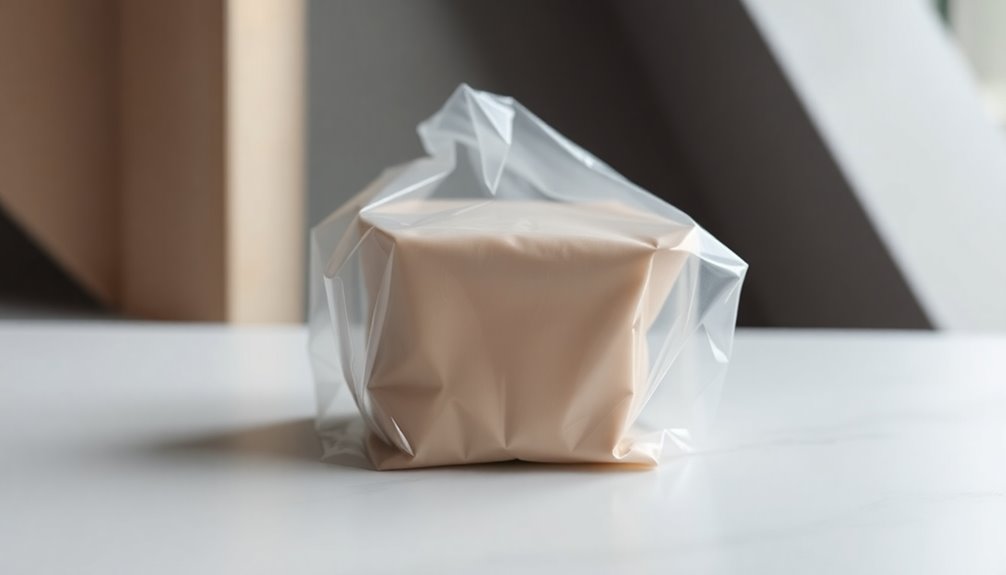
When you think about minimalist packaging, consider how sustainable materials play a vital role.
Brands are using innovative options like recycled plastics and biodegradable materials to create eco-friendly designs.
Cutting-edge techniques also enhance aesthetics and functionality, ensuring your products look great and are responsibly packaged. Additionally, incorporating energy efficiency into packaging design can further reduce environmental impact by minimizing resource consumption throughout the product's lifecycle.
Sustainable Material Choices
Embracing sustainable material choices in product packaging is essential for brands aiming to reduce their environmental impact. By opting for innovative materials, you can align your products with consumer preferences for eco-friendly options.
Consider incorporating:
- Biodegradable plastics that break down naturally, minimizing waste.
- Recycled paper, which supports a circular economy and reduces deforestation.
- Plant-based materials that are compostable and promote sustainability.
Additionally, using lightweight packaging not only conserves materials but also enhances transportation efficiency, lowering carbon emissions.
Choosing water-based inks and adhesives further guarantees your packaging is less harmful to the environment. These sustainable materials not only protect your products but also resonate with eco-conscious consumers, reinforcing your brand's commitment to a greener future.
Cutting-Edge Design Techniques
Innovative design techniques are transforming the landscape of minimalist product packaging, offering brands the chance to make a strong visual statement while reducing their environmental footprint.
By using cutting-edge design techniques like lightweight materials, you not only minimize waste but also enhance transportation efficiency, leading to lower carbon emissions.
Advanced printing techniques, such as digital printing, allow for clean designs that maintain brand identity without clutter. Incorporating features like QR codes delivers essential product information while keeping the look sleek.
You'll find creative solutions like modular structures and collapsible packaging emerging, which help you store products efficiently and use fewer materials while staying true to minimalist principles.
Embracing biodegradable plastics further solidifies your commitment to sustainability in design.
Balancing Aesthetics With Informational Needs
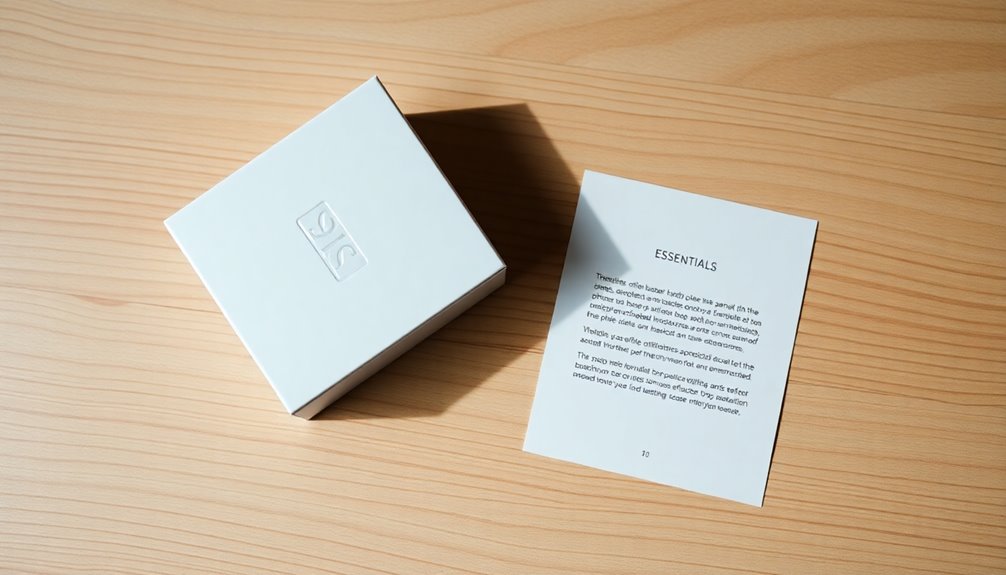
Minimalist packaging takes a bold approach to design, but it often struggles to convey essential product information effectively.
Minimalist packaging embraces striking design, yet it often fails to communicate vital product details clearly.
To strike a balance between aesthetics and clarity, brands need to explore innovative strategies.
- Utilize QR codes for detailed information without cluttering the design.
- Leverage technology, like Kiehl's Skin Match Technology, to enhance consumer interaction while maintaining a sleek appearance.
- Integrate digital platforms to deliver valuable information seamlessly and stylishly.
Adapting to Evolving Consumer Expectations
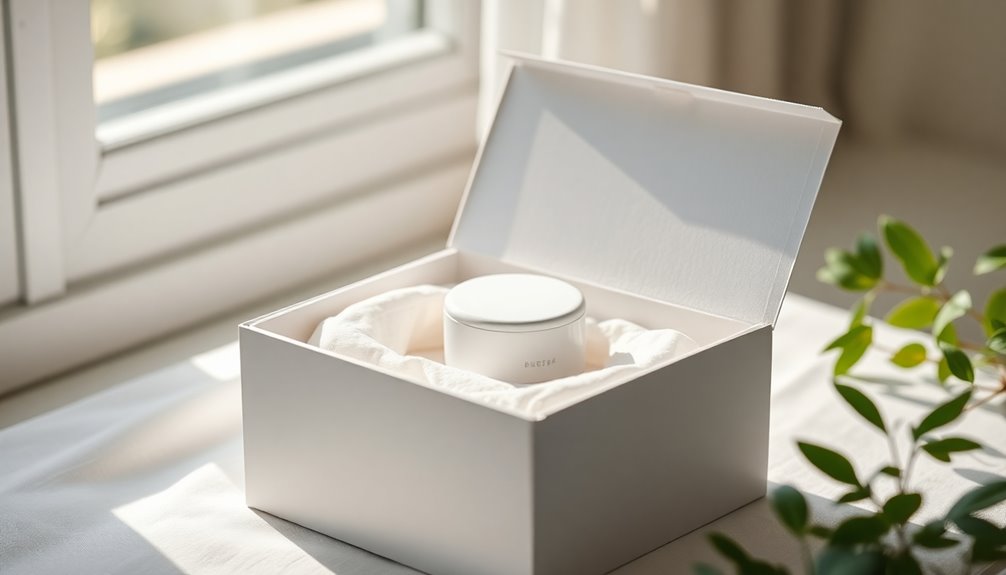
As consumer preferences shift towards simplicity and sustainability, brands must adapt their packaging strategies to meet these evolving expectations. With 72% of consumers more likely to purchase sustainably made products, embracing minimalist packaging is essential. This shift reflects a broader trend valuing authenticity and transparency. Here's a quick breakdown of key factors driving this change:
| Factor | Impact on Brands | Consumer Response |
|---|---|---|
| Minimalist Packaging | Enhances modern aesthetic | Increases purchase likelihood |
| Sustainability | Aligns with values | Boosts brand loyalty |
| Innovation in Strategies | Engages consumers effectively | Encourages informed choices |
The Future of Packaging: Trends and Predictions
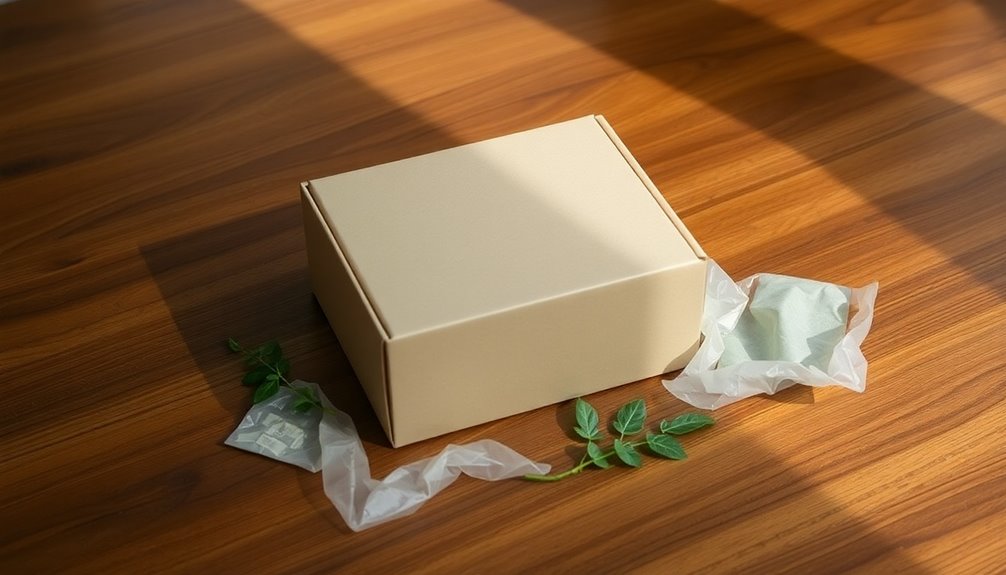
As you look ahead, you'll notice that sustainability-driven innovations are shaping the future of packaging.
Evolving consumer preferences demand smarter designs that marry eco-friendliness with practicality.
Technological advancements are making it easier for brands to create packaging that meets these expectations while enhancing user experience.
Sustainability-Driven Innovations
While many consumers are increasingly seeking sustainable options, brands face the challenge of innovating their packaging to meet these demands.
The shift towards minimalist packaging is largely driven by sustainability, with nearly 30% of shoppers opting for eco-friendly products. To stay relevant, brands must embrace innovations such as:
- Biodegradable and compostable materials
- Designs that minimize material usage
- Solutions that enhance product protection while reducing carbon footprints
As 72% of consumers show a preference for sustainably made products, adopting minimalist packaging isn't just a trend; it's a necessity.
Evolving Consumer Preferences
Consumer preferences are shifting rapidly, with a clear demand for products that prioritize sustainability and minimalism. As an evolving consumer, you're likely to favor brands that commit to environmental responsibility through minimalist packaging. Nearly 30% of shoppers are purchasing sustainable items more frequently, while 72% are inclined to buy products that reflect eco-conscious values. This trend indicates a strong alignment between minimalism and sustainability.
| Consumer Behavior | Percentage | Impact on Brands |
|---|---|---|
| Purchase Sustainable Items | 30% | Adapt packaging |
| Preference for Minimalism | 72% | Prioritize simplicity |
| Desire for Eco-Friendly | High | Innovate materials |
| Interest in Functionality | Essential | Balance aesthetics |
Minimalist packaging is set to redefine product presentation in the future.
Technological Advancements in Design
With advancements in design technology reshaping the packaging landscape, brands can now create innovative minimalist solutions that resonate with eco-conscious consumers.
You'll see how smart packaging technologies enhance user experience while reducing clutter, making it easier to access product information. The rise of biodegradable materials reflects a commitment to sustainability, showing that aesthetics don't have to be sacrificed.
- 3D printing and digital prototyping enable personalized designs.
- Automation in production minimizes waste and cuts costs.
- Augmented reality (AR) engages consumers, enhancing the unboxing experience.
These trends illustrate how technological advancements drive the future of packaging, aligning perfectly with minimalist principles and meeting the growing demand for eco-friendly solutions.
Frequently Asked Questions
What Is Minimalist Packaging?
Minimalist packaging focuses on simplicity and functionality. It strips away unnecessary elements, showcasing only what's essential for the product.
You'll notice clean lines and a clutter-free design that makes products more appealing. This approach not only reduces waste but also promotes sustainability by often using recycled or biodegradable materials.
When you choose minimalist packaging, you're supporting brands that prioritize eco-consciousness and efficiency, all while enjoying a visually striking product on the shelf.
Why Is Minimalism Important in Branding?
When it comes to branding, less is often more.
Minimalism's importance lies in its ability to foster clarity and enhance consumer understanding. By simplifying your message and design, you create a stronger emotional connection with your audience.
This approach not only boosts brand recall but also aligns with eco-conscious values, making your products more appealing to today's mindful consumers.
In a crowded marketplace, minimalist branding helps you stand out and earn trust.
What Is Minimalism in Product Design?
Minimalism in product design means focusing on simplicity and clarity, stripping away anything unnecessary.
You'll notice clean lines and an uncluttered aesthetic that highlights the product's core features.
This approach not only makes items visually appealing but also enhances authenticity and user experience.
What Makes a Product Minimalist?
When you think of a product as minimalist, picture simplicity versus clutter.
It's about stripping away excess, focusing on essential features that make the product stand out. You'll notice clean lines, muted colors, and straightforward typography.
There's a deliberate choice to use fewer materials, enhancing sustainability while still conveying the necessary information.
A minimalist product isn't just about looks; it's about creating a clear, engaging experience that resonates with your values and preferences.
Conclusion
As you explore the world of minimalist packaging, you might wonder what's next. With a growing focus on sustainability and consumer desires, brands are poised to push boundaries in ways you never imagined. Will these changes spark a revolution in how you perceive products? As you keep an eye on emerging trends, remember: the future of packaging is just around the corner, and it's about to redefine your shopping experience in ways you can't yet foresee.
